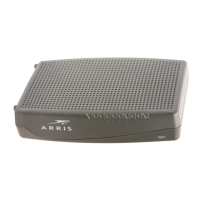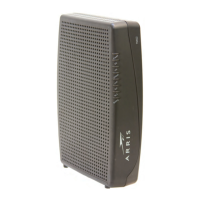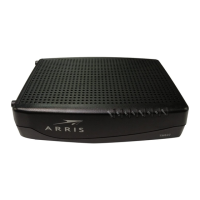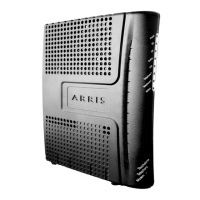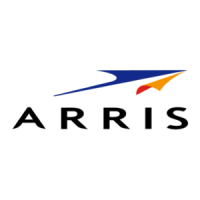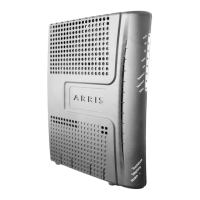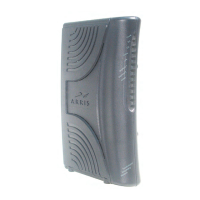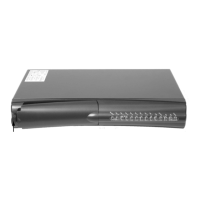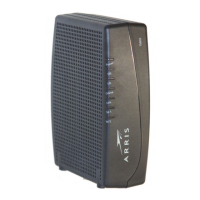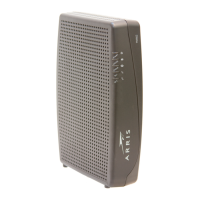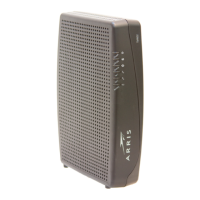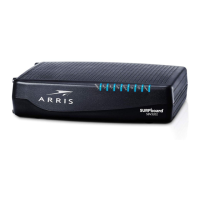Do you have a question about the Arris Touchstone TM804G and is the answer not in the manual?
Overview of the Touchstone TM804G Telephony Modem's capabilities and features.
Information on how to get assistance with the ARRIS product and where to find additional technical information.
Warnings regarding potential damage to equipment and loss of service from improper connections.
Warning about high voltages inside the unit and the need for qualified personnel for service.
Precautions related to battery handling, disposal, and conditions to avoid fire or explosion.
Details on compliance with FCC Part 15 rules for digital devices and managing interference.
Information on FCC radiation exposure limits and required minimum distance for installation and operation.
Details on compliance with Industry Canada regulations for radio transmitters and antenna gain.
Conditions for equipment operation in Mexico regarding harmful interference.
Overview of the Touchstone TM804G Telephony Modem's features and compliance standards.
List of items included in the Telephony Modem package.
List of necessary items and tools for installing the Telephony Modem.
Description of the coaxial cable used for connecting to the cable outlet and recommendations for quality.
Description of the standard phone cable used for telephone connections.
Explanation of how a splitter works and its potential impact on signal quality.
Steps and information required to contact the service provider and establish Internet and telephone service.
Details on operating system compatibility and service requirements for using the Telephony Modem.
Recommended computer hardware configuration for optimal use of the Telephony Modem's throughput.
Requirements for Windows operating systems (Vista, 7, 8, 10) for Ethernet or wireless LAN connection.
Requirements for Mac OS (7.5-9.2, X) for Ethernet or wireless LAN connection.
Requirements for Linux/Unix systems for Ethernet or wireless LAN connection.
Information on the scope of the manual and the location of the model number.
Tips to enhance system security when using a high-speed Internet connection.
Explanation of Ethernet connection method for networking computers.
Details on the type of Ethernet cable (CAT5e) required for gigabit Ethernet connections.
Information on the TM804G's Lithium-Ion backup battery for continued telephone service during outages.
Details on the basic backup battery models supported by the TM804G, including capacity and appearance.
Information on extended backup battery models, their capacity, and strap feature.
Details on the maximum backup battery, its backup time, and how it affects the modem's height.
Step-by-step guide for installing and replacing the basic backup battery.
Procedure for installing or replacing the extended backup battery.
Procedure for installing or replacing the maximum backup battery.
Guidelines for battery life expectancy, calibration, and proper storage.
Information on recycling rechargeable batteries through Call2Recycle.
How to check the battery status using the Telephony Modem's web interface.
Description of the LED indicator lights on the front panel of the Telephony Modem.
Identification and description of the connectors and controls on the rear panel of the Telephony Modem.
Factors to consider when choosing a location for the Telephony Modem.
Options for mounting the Telephony Modem on a wall or placing it on a desktop.
List of tools and materials required for wall-mounting the Telephony Modem.
Step-by-step instructions for securely mounting the Telephony Modem on a wall.
Instructions for positioning the Telephony Modem on a desktop for optimal ventilation and stability.
Procedure for connecting the Telephony Modem to the coaxial cable outlet.
Steps for connecting the power adapter and Ethernet cable to the Telephony Modem.
Instructions for connecting telephone cables to the Telephony Modem ports.
List of prerequisites for configuring the Ethernet connection, including computer and cable.
Overview of the chapter's structure and procedures for modifying TCP/IP settings.
Step-by-step guide to configure TCP/IP settings on a Windows Vista operating system.
Steps to configure TCP/IP settings on Windows 7, 8, or 10 operating systems.
Steps to configure TCP/IP settings on a Mac OS X operating system.
Instructions for setting up your computer to use the Telephony Modem, referencing service provider information.
Description of the LED indicator lights on the TM804G and their troubleshooting assistance.
Troubleshooting steps for battery incompatibility indicated by flashing lights.
Identifying and resolving issues related to telephone wiring, such as shorts or voltages.
Table showing light patterns during normal operation for Power, US/DS, Online, Link, Tel, and Battery indicators.
Tables detailing light patterns during telephony and cable modem startup phases.
Table describing light patterns during the cable modem startup sequence.
Instructions on how to use the reset button for modem initialization and troubleshooting.
Explanation of the 'Boot from Battery' feature for continued telephone service during power outages.
Steps to start the TM804G using its battery power, including battery insertion and reset button.
Steps to troubleshoot why the power light is off, checking connections and power sources.
Guidance for when the modem is not connecting to the Internet, checking lights and cable connections.
Troubleshooting steps for Ethernet connectivity problems, checking hub and cable.
Causes and solutions for a slow Internet connection, including web traffic and LAN interference.
Step-by-step guide to diagnose and resolve issues with no dial tone on the telephone lines.
Definitions of technical terms starting with A, C, D, and E used in the manual.
Definitions of technical terms starting with F, G, H, I, L, and M used in the manual.
Definitions of technical terms starting with P, R, S, T, and U used in the manual.
Overview of the Touchstone TM804G Telephony Modem's capabilities and features.
Information on how to get assistance with the ARRIS product and where to find additional technical information.
Warnings regarding potential damage to equipment and loss of service from improper connections.
Warning about high voltages inside the unit and the need for qualified personnel for service.
Precautions related to battery handling, disposal, and conditions to avoid fire or explosion.
Details on compliance with FCC Part 15 rules for digital devices and managing interference.
Information on FCC radiation exposure limits and required minimum distance for installation and operation.
Details on compliance with Industry Canada regulations for radio transmitters and antenna gain.
Conditions for equipment operation in Mexico regarding harmful interference.
Overview of the Touchstone TM804G Telephony Modem's features and compliance standards.
List of items included in the Telephony Modem package.
List of necessary items and tools for installing the Telephony Modem.
Description of the coaxial cable used for connecting to the cable outlet and recommendations for quality.
Description of the standard phone cable used for telephone connections.
Explanation of how a splitter works and its potential impact on signal quality.
Steps and information required to contact the service provider and establish Internet and telephone service.
Details on operating system compatibility and service requirements for using the Telephony Modem.
Recommended computer hardware configuration for optimal use of the Telephony Modem's throughput.
Requirements for Windows operating systems (Vista, 7, 8, 10) for Ethernet or wireless LAN connection.
Requirements for Mac OS (7.5-9.2, X) for Ethernet or wireless LAN connection.
Requirements for Linux/Unix systems for Ethernet or wireless LAN connection.
Information on the scope of the manual and the location of the model number.
Tips to enhance system security when using a high-speed Internet connection.
Explanation of Ethernet connection method for networking computers.
Details on the type of Ethernet cable (CAT5e) required for gigabit Ethernet connections.
Information on the TM804G's Lithium-Ion backup battery for continued telephone service during outages.
Details on the basic backup battery models supported by the TM804G, including capacity and appearance.
Information on extended backup battery models, their capacity, and strap feature.
Details on the maximum backup battery, its backup time, and how it affects the modem's height.
Step-by-step guide for installing and replacing the basic backup battery.
Procedure for installing or replacing the extended backup battery.
Procedure for installing or replacing the maximum backup battery.
Guidelines for battery life expectancy, calibration, and proper storage.
Information on recycling rechargeable batteries through Call2Recycle.
How to check the battery status using the Telephony Modem's web interface.
Description of the LED indicator lights on the front panel of the Telephony Modem.
Identification and description of the connectors and controls on the rear panel of the Telephony Modem.
Factors to consider when choosing a location for the Telephony Modem.
Options for mounting the Telephony Modem on a wall or placing it on a desktop.
List of tools and materials required for wall-mounting the Telephony Modem.
Step-by-step instructions for securely mounting the Telephony Modem on a wall.
Instructions for positioning the Telephony Modem on a desktop for optimal ventilation and stability.
Procedure for connecting the Telephony Modem to the coaxial cable outlet.
Steps for connecting the power adapter and Ethernet cable to the Telephony Modem.
Instructions for connecting telephone cables to the Telephony Modem ports.
List of prerequisites for configuring the Ethernet connection, including computer and cable.
Overview of the chapter's structure and procedures for modifying TCP/IP settings.
Step-by-step guide to configure TCP/IP settings on a Windows Vista operating system.
Steps to configure TCP/IP settings on Windows 7, 8, or 10 operating systems.
Steps to configure TCP/IP settings on a Mac OS X operating system.
Instructions for setting up your computer to use the Telephony Modem, referencing service provider information.
Description of the LED indicator lights on the TM804G and their troubleshooting assistance.
Troubleshooting steps for battery incompatibility indicated by flashing lights.
Identifying and resolving issues related to telephone wiring, such as shorts or voltages.
Table showing light patterns during normal operation for Power, US/DS, Online, Link, Tel, and Battery indicators.
Tables detailing light patterns during telephony and cable modem startup phases.
Table describing light patterns during the cable modem startup sequence.
Instructions on how to use the reset button for modem initialization and troubleshooting.
Explanation of the 'Boot from Battery' feature for continued telephone service during power outages.
Steps to start the TM804G using its battery power, including battery insertion and reset button.
Steps to troubleshoot why the power light is off, checking connections and power sources.
Guidance for when the modem is not connecting to the Internet, checking lights and cable connections.
Troubleshooting steps for Ethernet connectivity problems, checking hub and cable.
Causes and solutions for a slow Internet connection, including web traffic and LAN interference.
Step-by-step guide to diagnose and resolve issues with no dial tone on the telephone lines.
Definitions of technical terms starting with A, C, D, and E used in the manual.
Definitions of technical terms starting with F, G, H, I, L, and M used in the manual.
Definitions of technical terms starting with P, R, S, T, and U used in the manual.
| Modem Type | DOCSIS 3.0 |
|---|---|
| Maximum Download Speed | 343 Mbps |
| Maximum Upload Speed | 131 Mbps |
| Channels | 8 Downstream, 4 Upstream |
| Ethernet Ports | 4 |
| Voice Ports | 2 |
| Weight | 1.5 lbs |
| Wireless | No |
